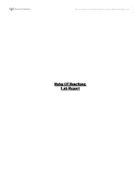Rates Of Reactions:
Lab Report
Introduction:
In chemistry recently we have been doing the topic of Reactions. In this topic we have been learning about why elements react, how they react and what affects the reaction. For instance, temperature affects the speed of a reaction, and sometimes if there is any reaction at all.
Aim:
The aim of my experiment is to see how the factor of surface area affects the speed (rate) of a reaction between Hydrochloric Acid and Calcium Carbonate.
Hypothesis:
I know that the greater the surface area, the faster the reaction. Hence I predict that when I react Hydrochloric Acid with Calcium Carbonate, the Calcium Carbonate marbles will react slower than the Calcium Carbonate powder, as I think the powder has a higher surface area. The variables are as follows:

This is a preview of the whole essay
Peer Reviews
Here's what a star student thought of this essay
Quality of writing
The investigation is easy to follow because of the precise use of language and the fact that there are little-to-no grammatical or spelling errors; technical terms are also used when necessary. A good feature is the use of subtitles for each paragraph as they make the logical progression of the task clear to see. It makes life of the examiner a lot easier too, as it immediately shows that the student knows what the subject well and has hit all the assessment objectives. One criticism that could be made is that, perhaps, the student has stuck to the structure too rigidly and shows a lack of creativity, but at GCSE level, this is unlikely to be marked down at all, especially in a scientific subject.
Level of analysis
As already mentioned, this student set out with a clear aim for the task. They carried out the investigation to the level of detail expected at GCSE level, with a written explanation of the method and all the background formulae. The conclusion is logical based on the evidence and the student does a good job of summing up the results of the experiment, however, and improvement would be to also add some information on why these results occurred as opposed to linking to a website with an explanation. In general though, the candidate displayed strong understanding as well as additional skills such as drawing the diagrams and graphs which is very important for scientific subjects. There is a good discussion on errors that could have been made, although this could have been expanded on a little. It is important to understand errors in experiments as they can have a huge bearing on the results and a more insightful analysis of this could have really made the essay stand out.
Response to question
In this essay, the student presents the write-up of an experiment into rates of reaction in a clear, logical order. A good level of understanding is demonstrated, with key terms being explained such as what the independant and dependant variables are. The candidate begins with a solid hypothesis to investigate and ends with a conclusion to analysise the results, in which there are comments on whether the original idea was correct or not. This is important as, even if your hypothesis was wrong, it indicates you can, not only, correctly carry out an experiment but also identify what the results show.








